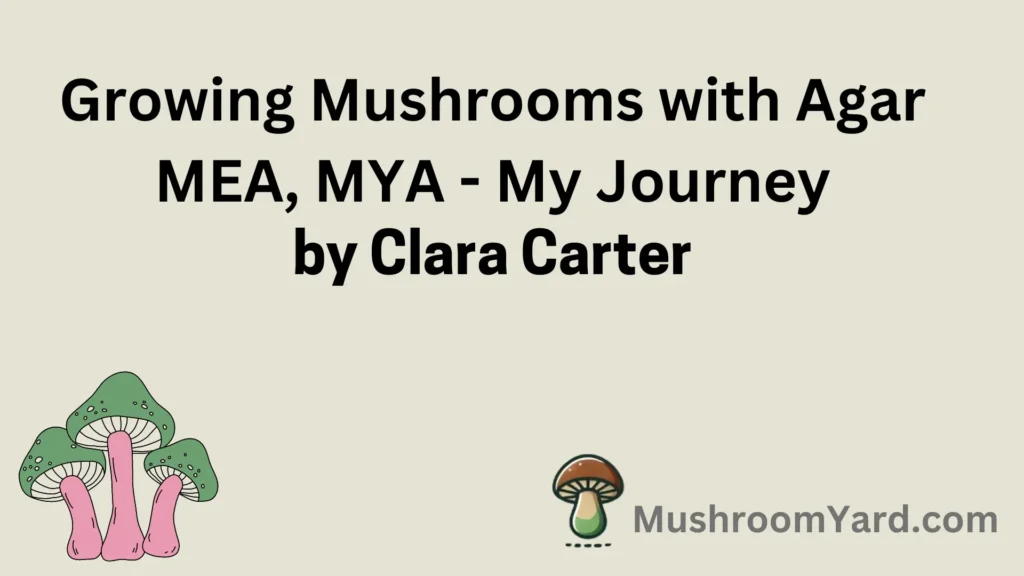

Starting my mushroom cultivation journey was both thrilling and a bit intimidating. As I navigated through the intricacies of mycology, I quickly realized the significance of using agar in growing mushrooms. It wasn’t just a medium; it was the key that could unlock mycelial potential. In this guide, I’ll share my experiences with agar, including rhizomorphic mycelium, MEA, MYA plates, and the innovative no-pour jar method that has transformed my cultivation practices.
Note that: This is how I grew mushrooms with Agar. Here I have only described what I did and this is not a complete agar growing guide. I will share a complete agar growing guide later on. I thought it could encourage new mushroom growers to use Agar that’s why I am sharing my experience through this article.
Agar is a gelatinous substance made from algae. I have witnessed agar as a great growth medium for mushrooms. Create a sterile environment and it will control the cultivation process. This control is essential for healthy mycelium. When starting with spores or cloning mushrooms, agar creates an ideal setting for growth.
Note: If you notice cobweb mold on mycelium, it’s important to get rid of it. You can check my previous guide on this: How to Get Rid of Cobweb Mold on Mycelium
The benefits of using agar are clear: it minimizes contamination risks, facilitates easy transfers, and helps the observation of mycelial growth patterns. With agar, I’ve found it easier to identify healthy cultures and make clean transfers.
In mycelium growth, I’ve noticed two main patterns: rhizomorphic and tomentose. Rhizomorphic mycelium resembles a network of roots that spreads out in search of nutrients. This pattern is visually striking and beneficial for cloning and transferring mycelium.
I’ve discovered that rhizomorphic mycelium is preferred for transfers because it is easier to distinguish and generally indicates a stronger culture. This clarity has significantly improved my success rate when propagating mycelium. I have shared two pictures of Rhizomorphic and Tomentose mycelium so that you can distinguish them.
This provides a clear comparison of tomentose and rhizomorphic mycelium. The portion at the top shows tomentose growth, which focuses on nutrient absorption and grows more slowly. The section at the bottom illustrates rhizomorphic growth, which extends outward in search of nutrients.
One of my favorite recipes for starting cultures is water agar. This straightforward yet effective medium supports mycelium growth while minimizing the risk of contamination. Here’s my method for making it:
Ingredients:
Instructions:
Water agar is particularly useful during the initial growth stages, as it provides just the right amount of nutrients for the mycelium to spread while keeping unwanted contaminants at bay. I’ve experienced impressive results using this method, making it my go-to choice for spores and clones.
Tip: If you want to increase the effectiveness of your water agar, you can add a few drops of sterile liquid culture or nutrient solution before pouring it into Petri dishes. It can give your mycelium an extra boost during its early growth stages.
After achieving healthy growth on water agar, I move on to Malt Extract Agar (MEA) for a nutrient boost. Here’s the recipe I follow:
Ingredients:
Fine-tuning the nutrient levels has been crucial for promoting rhizomorphic growth. When I slightly reduced the amount of malt extract, I noticed that mycelium extended further in search of nutrients. This adjustment improved growth patterns and lowered the chances of contamination.
Ingredients:
Using nutritional yeast can introduce cloudiness to the agar, but I’ve found this doesn’t lead to contamination. Instead, it creates a nutrient-rich environment that supports vigorous mycelial growth. The key is to grind the nutritional yeast into a fine powder for optimal integration into the agar mix.
If you wish you can skip this step.
Using the no-pour jar method has transformed my cultivation process. This technique lets me prepare agar directly in jars, which greatly reduces the risk of contamination from exposure to open air.
Tips for Success:
This method has streamlined my workflow and helped me manage cultures more effectively. I also flip my Petri dishes or jars upside down to prevent condensation and keep the agar clean.
Cloning mushrooms has been one of the most rewarding parts of my journey. After I establish a healthy culture on water agar, I transfer a clean sample to an MEA plate. With each transfer, I focus on the best rhizomorphic growth, which helps me isolate and propagate strong mycelium.
Step-by-Step Guide:
This approach has not only increased my cloning success rate but also deepened my understanding of how different agar recipes influence growth.
Reflecting on my mushroom cultivation journey, using agar has been a transformative experience. From the simplicity of water agar to the nutrient-rich MEA and MYA plates, each step has contributed significantly to producing clean, robust mycelium. I encourage fellow enthusiasts to try these agar recipes and techniques—you might find surprising results, just as I did. Happy cultivating!
If you like my journey share it with other mushroom growers.